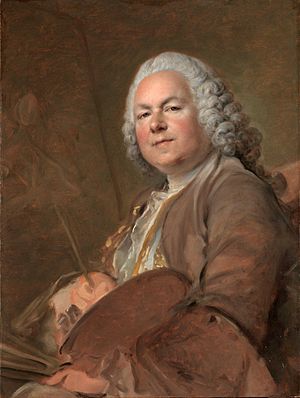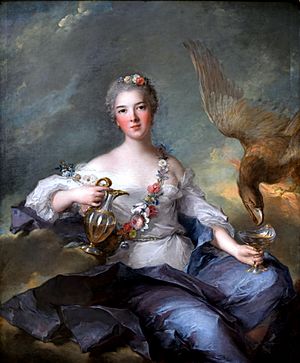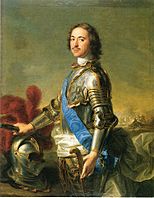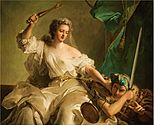Jean-Marc Nattier facts for kids
Quick facts for kids
Jean-Marc Nattier
|
|
|---|---|

Portrait of Jean-Marc Nattier by Louis Tocqué (late 1740s)
|
|
| Born |
Jean-Marc Nattier
17 March 1685 Paris, Kingdom of France
|
| Died | 7 November 1766 (aged 81) Paris, Kingdom of France
|
| Nationality | French |
| Known for | Painting |
| Movement | Rococo |
Jean-Marc Nattier (born March 17, 1685 – died November 7, 1766) was a famous French painter. He was born in Paris, France. His father, Marc Nattier, was also a portrait painter, and his mother, Marie Courtois, painted tiny pictures called miniatures. Jean-Marc Nattier became well-known for painting portraits of the ladies at King Louis XV's court. He often showed them dressed up as characters from ancient Greek and Roman myths.
About Jean-Marc Nattier's Life
Jean-Marc Nattier learned to paint from his father. He also learned from his uncle, Jean Jouvenet, who was a history painter. In 1703, when he was 18, Nattier joined the Royal Academy in Paris.
He spent time copying famous paintings at the Luxembourg Palace. He made many drawings of the "Marie de Médici painting cycle" by Peter Paul Rubens. These drawings were later made into prints in 1710, which made Nattier quite famous.
Even though he won first prize at the Paris Academy at age 15, he chose not to go to the French Academy in Rome. In 1715, he traveled to Amsterdam. There, he painted portraits of Peter the Great, the Russian ruler, and his wife, Empress Catherine. He was even offered a job in Russia, but he decided not to go.
Nattier really wanted to be a history painter, someone who paints big scenes from history or mythology. Between 1715 and 1720, he worked on large paintings like the Battle of Pultawa for Peter the Great. Another important work was The Petrification of Phineus and his Companions. This painting helped him become a member of the Royal Academy. Jean-Marc Nattier passed away in Paris in 1766.
His Famous Portraits
Around 1720, a big financial crisis happened in France. This event, caused by a plan from John Law, almost ruined Nattier. Because of this, he had to focus on painting portraits, as it paid much better. He became the favorite painter for the ladies of King Louis XV's court.
Nattier brought back a special kind of portrait called an "allegorical portrait." In these paintings, a real person is shown as a Greek or Roman goddess or another mythical character. This made the portraits more interesting and artistic.
His elegant and charming portraits of court ladies were very popular. People loved them because Nattier could make the person look beautiful while still keeping their true likeness. Some of his most famous straightforward portraits include Marie Leczinska at the Dijon Museum. Another is the group portrait The Artist Surrounded by His Family, painted in 1730.
A great example of Nattier's skill is his 1738 portrait of Mathilde de Carbonnel-Canisy, marquise d’Antin. This painting is always on display at the musée Jacquemart-André in Paris. It is one of the most loved artworks in that collection.
Many of Nattier's important paintings are shown in major museums around the world. For example, at the Louvre museum, you can see his Magdalen. The Musee Jacquemart-Andre has his Portrait of Mathilde de Canisy, marquise d'Antin. In Nantes, there are portraits of La Camargo and A Lady of the Court of Louis XV.
Other museums with his works include Orléans, which has a Head of a Young Girl. Marseilles has a portrait of Mme de Pompadour. Perpignan has a portrait of King Louis XV, and Valenciennes has a portrait of Le Duc de Boufflers. The Versailles Museum has a significant group of two ladies. The Dresden Gallery displays a portrait of the Maréchal de Saxe.
At the Wallace Collection in London, you can find The Comtesse de Tillières (also known as Portrait of a Lady in Blue). Also there are Mademoiselle de Clermont en sultane and The Marquise de Belestat.
The Staatliche Kunsthalle Karlsruhe has his 1753 painting of the Marquis de Marigny. The Getty Museum owns Madame Bonier de la Mosson as Diana, painted in 1742. The Metropolitan Museum of Art has Madame de Maison-Rouge as Diana, from 1756. The 1744 painting Duchesse de Chartres as Hebe is part of the Nationalmuseum collection.
Gallery of Paintings
-
-
-
Madame de Pompadour as Diana the Huntress
(1746)
Versailles, Musée national du Château et des Trianons -
Marie Leszczyńska, Queen of France, Reading the Bible
(1748)
Versailles, Musée national du Château et des Trianons -
-
See also
 In Spanish: Jean-Marc Nattier para niños
In Spanish: Jean-Marc Nattier para niños












